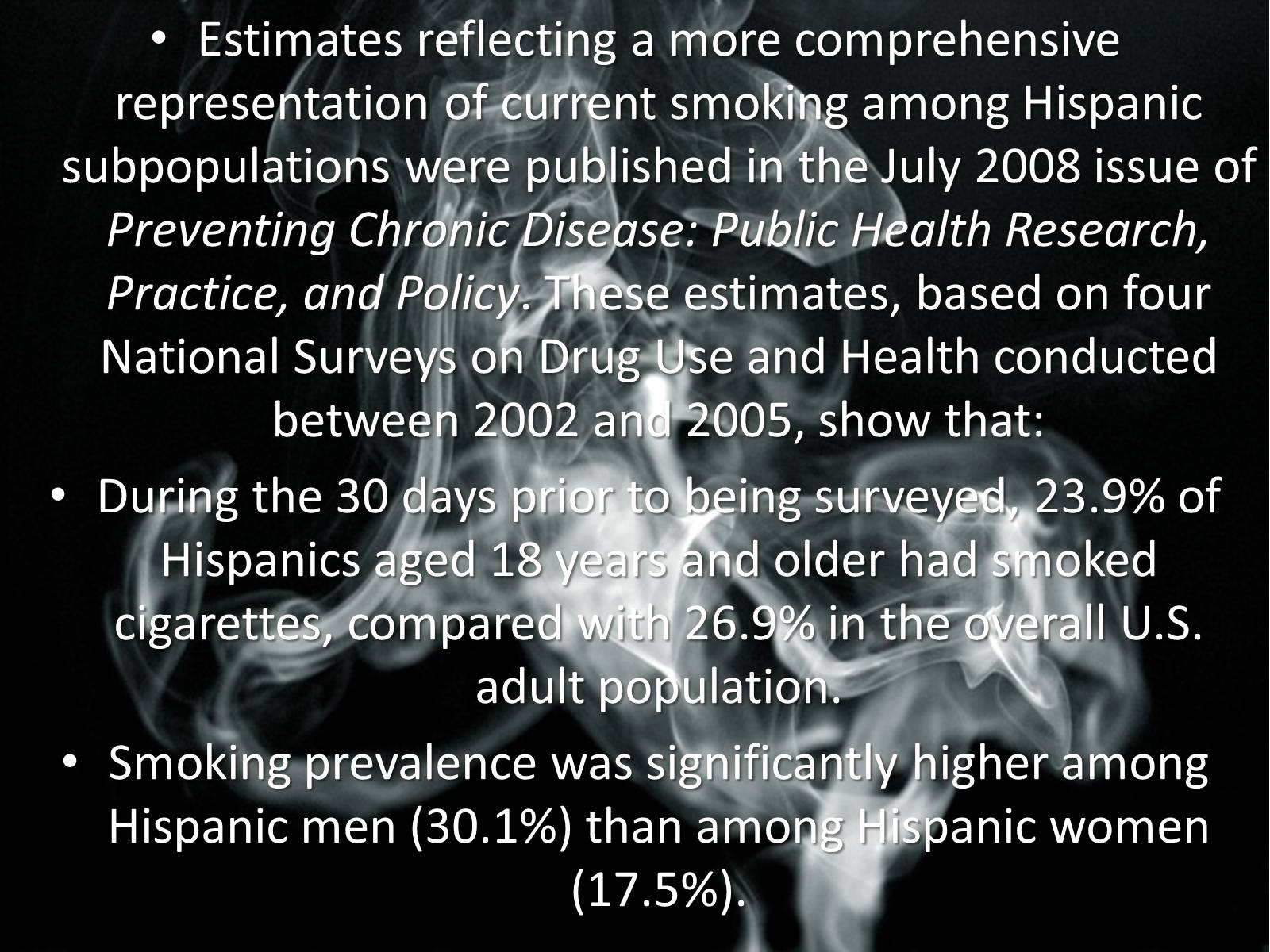Презентація на тему «Cigarette Smoking in the United States»

Cigarette Smoking in the United States

Current Cigarette Smoking Among U.S. Adults Aged 18 Years and Older
Tobacco use remains the single largest preventable cause of death and disease in the United States. Cigarette smoking kills more than 440,000 Americans each year, with an estimated 49,000 of these deaths from exposure to secondhand smoke. In addition, smoking-related illness in the United States costs $96 billion in medical costs and $97 billion in lost productivity each year.

In 2011, an estimated 19.0% (43.8 million) U.S. adults were current cigarette smokers. Of these, 77.8% (34.1 million) smoked every day, and 22.2% (9.7 million) smoked some days.

Current Cigarette Smoking Among Specific Populations — United States

American Indian/Alaska Natives
American Indian/Alaska Natives (AI/ANs) have a higher prevalence of current smoking than most other racial/ethnic groups in the United States, making cigarette smoking a serious problem to the health of that population.

In 2011
31.5% of AI/AN adults in the United States smoked cigarettes, compared with 19.0% of U.S. adults overall.
The prevalence of current smoking was higher among AI/AN men (34.4%) than among AI/AN women (29.1%).
From 2005 to 2011, no significant change in current smoking prevalence occurred among AI/AN adults (32.0% in 2005 to 31.5% in 2011).

Asians
Asian Americans represent a wide variety of languages, dialects, and cultures. While non-Hispanic Asian adults have the lowest current smoking prevalence of any racial/ethnic group in the United States, there are significant differences in smoking prevalence among subgroups in this population. Smoking is a risk factor for many forms of cancer, heart disease, and stroke, which are the leading causes of death in this population.

In 2011
9.9% of non-Hispanic Asian adults in the United State smoked cigarettes, compared with 19.0% of U.S. adults overall.
Smoking prevalence was significantly higher among non-Hispanic Asian men (14.9%) than among non-Hispanic Asian women (5.5%).
From 2005 to 2011, a decline in current smoking prevalence among non-Hispanic Asian adults occurred (from 13.3% in 2005 to 9.9% in 2011).

Estimates reflecting a more comprehensive representation of current smoking among Asian subpopulations were published in the July 2008 issue of Preventing Chronic Disease: Public Health Research, Practice, and Policy. These estimates, based on four National Surveys on Drug Use and Health conducted between 2002 and 2005, show that:
During the 30 days prior to being surveyed, 14.5% of Asians aged 18 years and older had smoked cigarettes, compared with 26.9% in the overall U.S. adult population.
Smoking prevalence was significantly higher among Asian men (21.6%) than among Asian women (8.1%).

The percentage of respondents who reported smoking within the past 30 days by subpopulations surveyed were:
Chinese - 8.8%
Asian Indian - 11.9%
Japanese - 12.1%
Filipino - 16.7%
Vietnamese - 21.5%
Korean - 26.6%
Among women, smoking prevalence ranged from 3.5% among Asian Indians to 20.1% among Koreans.
Among men, smoking prevalence ranged from 13.9% among Chinese individuals to 37.4% among Koreans.

Blacks
The prevalence of current smoking among non-Hispanic black adults is similar to the prevalence among adults in the general population and among non-Hispanic white adults (20.6%). However, smoking remains a serious problem for this population.

In 2011
19.4% of non-Hispanic black adults in the United States smoked cigarettes, compared with 19.0% of U.S. adults overall.
Smoking prevalence was significantly higher among non-Hispanic black men (24.2%) than among non-Hispanic black women (15.5%).
From 2005 to 2011, no significant change in current smoking prevalence occurred among non-Hispanic blacks (from 21.5% in 2005 to 19.4% in 2011).

Hispanics
The prevalence of cigarette smoking among Hispanics is generally lower than the prevalence among other racial/ethnic groups in the United States, with the exception of non-Hispanic Asians. However, smoking prevalence among Hispanic men is significantly higher than among Hispanic women, and cigarette smoking remains a serious health concern in this population. Cigarette smoking is a risk factor for heart disease and stroke, which are leading causes of death for Hispanics in the United States.

In 2011
12.9% of Hispanic adults in the United States smoked cigarettes, compared with 19.0% among U.S. adults overall.
Smoking prevalence was significantly higher among Hispanic men (17.0%) than among Hispanic women (8.6%).
From 2005 to 2011, a decline in current smoking prevalence among Hispanics was noted (from 16.2% in 2005 to 12.9% in 2011).

Estimates reflecting a more comprehensive representation of current smoking among Hispanic subpopulations were published in the July 2008 issue of Preventing Chronic Disease: Public Health Research, Practice, and Policy. These estimates, based on four National Surveys on Drug Use and Health conducted between 2002 and 2005, show that:
During the 30 days prior to being surveyed, 23.9% of Hispanics aged 18 years and older had smoked cigarettes, compared with 26.9% in the overall U.S. adult population.
Smoking prevalence was significantly higher among Hispanic men (30.1%) than among Hispanic women (17.5%).

The percentage of respondents who reported smoking within the past 30 days by subpopulations surveyed were:
Central or South American - 20.2%
Mexican - 23.8%
Cuban - 25.2%
Puerto Rican - 31.5%
Among women, smoking prevalence ranged from 14.7% among Central or South Americans to 28.0% among Puerto Ricans.
Among men, smoking prevalence ranged from 25.3% among Central or South Americans to 35.6% among Puerto Ricans.

Military Service Members and Veterans
In the United States, smoking prevalence is higher among people serving in the military than among the civilian population. Smoking prevalence is even higher among military personnel who have been deployed.
Among men aged 25–64 during 2007–2010, 29% of veterans reported being current cigarette smokers, compared with 24% of those who had not served in the military.
Among men aged 45–54 years during 2007–2010, 36% of veterans reported being current cigarette smokers, compared with 24% of those who had not served in the military.

Facts About Secondhand Smoke
An estimated 88 million nonsmokers in the United States breathe other peoples' tobacco smoke.
Each year, about 46,000 nonsmokers in the United States die from heart disease caused by secondhand smoke.
Secondhand smoke exposure causes an estimated 3,400 lung cancer deaths annually among adult nonsmokers in the United States.
Nonsmokers who are exposed to secondhand smoke at home or work increase their lung cancer risk by 20–30%.
Secondhand smoke exposure is higher among persons with low incomes: 60.5% of persons living below the poverty level in the United States were exposed to secondhand smoke in 2007–2008, compared with 36.9% of persons living at or above the poverty level.

The end